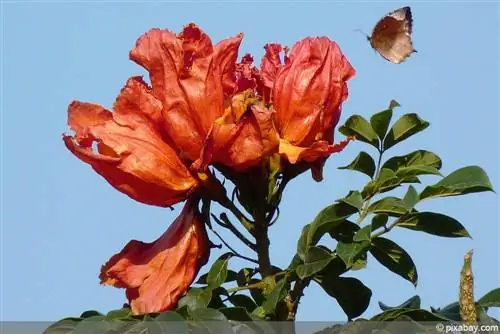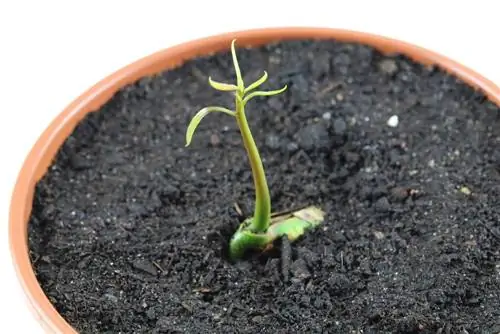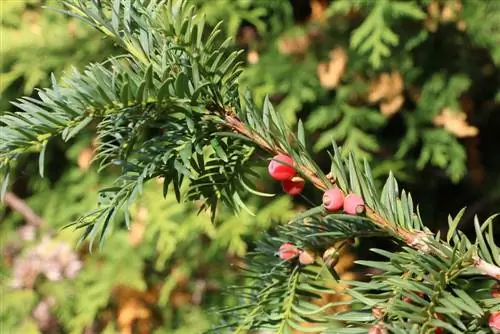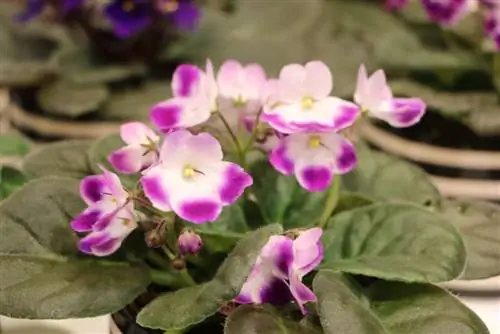- Author admin [email protected].
- Public 2023-12-17 03:39.
- Last modified 2025-01-24 12:45.
African tulip tree delights flower lovers with the most spectacular flowers from the world of tropical plants. As soon as the flower stalks look proudly out of the evergreen crown, an impressive spectacle begins: after the outer circle of flowers has faded, the next row of buds begins to bloom. Each flower lasts for weeks. Spathodea campanulata needs a suitable location, then care is effortless.
Location in summer
The ideal place for an African tulip tree is definitely not outdoors due to the climatic conditions in this country. In order for it to develop its full splendor and transform into a sea of flowers, it needs tropical conditions:
- lots of warmth
- high humidity
- sunny to full sun location
- Consistently consistent temperatures
- lots of space
In temperate climates it is a typical container plant, a resident of closed spaces. Only in the hot summer months is this plant from the trumpet tree family allowed to be temporarily outdoors, in a bright, sunny and wind-protected spot. Only plants that have already developed woody branches are allowed outdoors.
A greenhouse and a light-flooded winter garden offer the trumpet tree consistently good living conditions, so that the best flowering success is achieved there. However, over the years the tree can reach an impressive size - even if it is trimmed regularly. Therefore, the future space requirements must be taken into account when purchasing or sowing a new plant yourself. It needs enough space to grow upwards, but also enough space for the roots to develop.
Location in winter
Because of its origins on the hot continent, the African tulip tree is more sensitive to low temperatures than other tulip tree species. If he has been left outside over the summer, he definitely needs to go back in during the cold days as he still needs a warm environment.
- no longer outdoors from autumn
- Warmth of at least 20 degrees
- do not expose to frost
- Temperatures not below 10 degrees
- Temperatures around 3 degrees are only possible for a short time
Under no circumstances should the African tulip tree be exposed to frosts, as these cause irreparable damage, particularly to the roots of the tree.
Note:
African tulip tree loses some of its green leaves in winter. In spring, around April, new leaves sprout again. So no need to worry.
Planting soil

Drained soil with plenty of nutrients works well for an African tulip tree. This should also be enriched with coarse-grained material, such as gravel, lava grit or expanded clay. They loosen the soil and keep it nice and airy. A humus portion also stores nutrients and water. Here it is worth choosing high-quality potting soil, even if it is more expensive.
Seed cultivation
An African tulip tree can be grown all year round from the bright and light seeds. Pre-treatment of the seeds is not necessary. However, pre-soaking the seeds in warm water will not accelerate subsequent germination. The germination time is around 2-3 weeks, provided the temperature is constantly just above 20 degrees.
For sowing, instead of normal potting soil, use nutrient-poor and air-permeable potting soil, which is available in garden centers.
- Fill a small pot with potting soil
- Put the seeds on top.
- Cover the seeds with a thin layer of soil
- Press the soil and press it lightly with your fingers.
- Cover the pot with cling film to prevent water evaporation.
- Place the pot with the seeds in a bright place
- Ensure even heat around 20 degrees
- Keep soil moist throughout, it must not dry out.
- Avoid waterlogging.
Note:
Ventilate every 2-3 days by removing the foil cover for a few minutes. This prevents mold formation.
Young plants
As soon as the first signs of a plant are visible, it must be protected from the blazing sun. Change location if necessary. This precautionary measure is particularly advisable if a hot summer was chosen for sowing. When the germinated African tulip trees have grown a little larger, you can prick out the seedlings individually.
After about 8 weeks they should have reached the appropriate size of about 10 cm. Be careful with the still tender roots so that they are not damaged. You can now expose the young plants to the sun carefully and in doses so that they slowly get used to it and do not suffer any burns to their leaves.
Propagation of cuttings
Young shoots cut off in spring can be used for propagation. They are placed in pots with potting soil.
- Keep the ambient temperature constant at at least 20 degrees
- Keep growing soil moist
- use soft watering water
- Place foil over the shoots
New shoots and leaves are a sign that everything went well and the cutting has taken root.
Tip:
Use rooting aid, it supports and accelerates the formation of new roots. Propagation through grafting is another way to propagate the African tulip tree, but this requires appropriate knowledge and is rather unsuitable for laypeople.
Pouring
The African tulip tree needs regular and lots of water. The earth must never dry out, especially in summer. The African tulip tree is extremely sensitive to drought. Its leaves turn brown at the edges or even fall off completely. Since this occurs with a time delay, the brown leaves are often not associated with drought.
The water requirement is lower in winter than in summer due to lower air temperatures and the upcoming growth break. Nevertheless, this exotic tree needs consistently moist soil even in winter - but without standing in water.
Fertilize
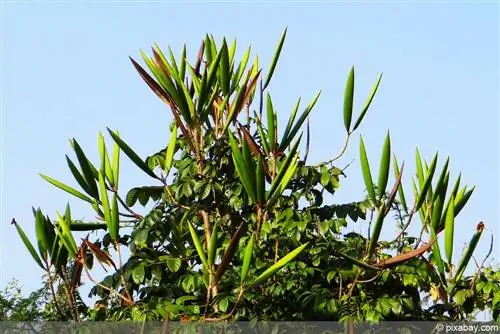
In order to develop its magnificent, palm-sized flowers, the African tulip tree needs regular amounts of fertilizer throughout its entire growing season from April to October. A commercially available complete fertilizer for flowering potted plants is completely sufficient. Once a week, the amount required according to the packaging is added to the irrigation water and watered.
You can also use stick fertilizer or slow-release fertilizer, but these must be refreshed in good time. Rhododendron fertilizer and other acidic fertilizers are also suitable. Fertilizer is no longer required from November. The roots of this tree can no longer absorb fertilizer during the cool time of the year.
Repotting
As the African tulip tree grows, the size of the pot must also grow accordingly. A new pot is due about once a year. Only repot this ornamental tree in small steps. The new pot should only be a few centimeters wider than the old one. To ensure that the tree is disturbed as little as possible during growth, it should be repotted in high-quality soil immediately before the start of a new growth phase in March. Since this trumpet tree is poisonous, you should wear gloves.
Note:
If the new pot is too large, the tree will take longer to fill it with new roots. This delays further growth of the above-ground shoots, and flower formation also suffers.
How to cut the tulip tree?
The African tulip tree does not require any pruning, at least not if it has enough space to develop and this free growth is desired. In the first few years of life, the tree hardly branches, then cutting can stimulate branching. Otherwise, if the tree is to remain small, it must be cut carefully in order to tame it.
Topiary
- Never cut radically
- It's better to have a smaller cut every year
- Best time: April and May
- Use a sharp and clean cutting tool
- Green and woody shoots may be cut
- Cut only as much as absolutely necessary
- Cut inward-growing shoots
- Remove unfavorable shoots growing out
Note:
The African tulip tree is poisonous in all parts. To protect yourself, always wear gloves and do not leave cut-off pieces lying around.
Conservation cut
Every now and then individual parts of the plant can dry out. These dead branches and shoots should be removed promptly, as should branches that have been accidentally snapped. Branches that are affected by pests and diseases must also be cut out immediately to stop the spread of the disease.
- Time for editing: immediately
- Use a sharp and clean cutting tool
- Wear gloves as it is poisonous
- Green and woody shoots may be cut
- Remove all dead shoots
- Cut all sick and affected shoots
- Clean and disinfect the cutting tool afterwards.
Tip:
When it comes to pest infestations and diseases, the location and previous care should be critically examined in order to adapt them to prevent such damage in the future.
Flowering time
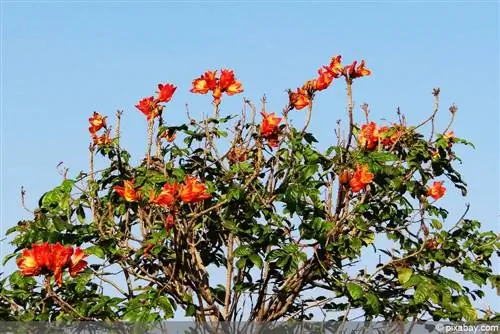
In their homeland, African tulip trees bloom all year round. This is a flower dream that unfortunately cannot be fulfilled here. Furthermore, it takes several years until Spathodea campanulata finally shows its first flowers. We're talking about 3 to 7 years, so patience is required.
The individual flowers are about 10 centimeters long and are reminiscent of a bell, the edge of which is unusually frayed. They do not come individually, but rather are circular and arranged in several rows. The outer flower wreath blooms first, as soon as it has faded, the closest flower wreath follows and so on. The flowers shine in yellow, orange or red from May onwards. The light brown sepals are speckled with dark dots.
Almost all withered and dried flowers fall off on their own. However, some dried flowers remain standing. You can remove these carefully. Use a clean and sharp tool for this. Always remember to wear gloves, because this trumpet tree is as poisonous as it is beautiful. Also remove any dried leaves that accumulate in the container to prevent rot from occurring. After flowering, seeds form that can be used for propagation.
Diseases and pests
The tulip tree is quite resistant to native diseases. Only too much watering and the resulting waterlogging can cause the roots to rot. Unfortunately, a fungicide must then be used to combat it. It's much better to prevent it with the right care and not let it get to that point in the first place.
Brown discoloration on leaves and flowers is caused by lack of water or soil s alts. Once the cause is eliminated, improvement occurs. Root damage due to hypothermia also occurs if the tree is exposed to temperatures below 3 degrees for a long period of time in winter.
The tulip tree is not susceptible to pests. If so, imported plants are more likely to be affected. They leave feeding marks and holes on the leaves and bark and require quick action. Examine the plant thoroughly to accurately identify the pest. Treat the plant with an appropriate product. If necessary, you must remove damaged plant parts.

